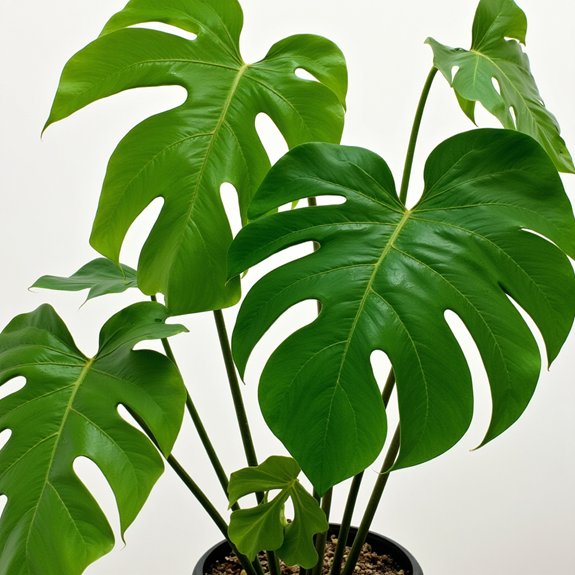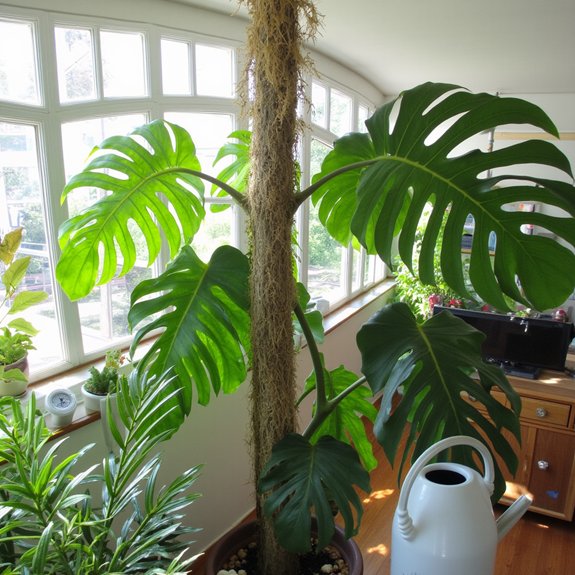Monstera enthusiasts often wonder why their beloved plants stubbornly refuse to develop those iconic split leaves, despite months of careful attention. The truth is, fenestration doesn’t happen overnight, and several precise factors must align before a Monstera will produce its characteristic perforated foliage. Most plant owners make critical mistakes during the first two years, unknowingly preventing their Monstera from reaching the maturity threshold required for splits to emerge.
Contents
What Makes Monstera Plants Special

Among the thousands of houseplants available today, Monstera stands out as something truly extraordinary. These tropical plants, originating from Central and South America, bring jungle vibes directly into living spaces. Their unique aesthetics center around fenestration, the distinctive holes and splits that develop in mature leaves.
What makes Monsteras particularly special is their transformation over time. Young plants start with solid, heart-shaped leaves, then gradually develop their signature perforations as they mature, typically around two to three years of age. This evolutionary display creates an ever-changing focal point that captivates plant enthusiasts worldwide.
The Science Behind Leaf Fenestration
While fenestration creates Monstera’s most recognizable feature, botanists still puzzle over why these splits and holes actually develop. The leading theory suggests these botanical adaptations help maximize photosynthesis by creating gaps that allow sunlight to reach lower leaves. This unique leaf morphology may also serve practical purposes in tropical environments.
Wind resistance represents another compelling explanation, as splits prevent large leaves from acting like sails during storms. Additionally, holes allow rain to pass through rather than pooling on leaf surfaces, reducing weight and potential damage. These adaptations likely evolved over millions of years in Central American rainforests.
When to Expect Your Monstera Leaves to Split

The timing of leaf fenestration depends primarily on your plant’s age, with most Monstera deliciosa developing their first splits around the one-year mark under ideal conditions. However, leaf maturity varies considerably based on environmental factors like light, water, and nutrients.
Most indoor Monsteras reach full maturity between two to three years, when fenestration becomes consistent. The growth timeline can extend longer in suboptimal conditions, with some plants taking four years or more to produce split leaves.
Young plants naturally produce solid leaves first, so patience remains essential. After three years in proper conditions, new growth should consistently display the characteristic holes and splits.
Common Reasons Why Leaves Stay Solid
Despite providing proper care, many Monstera owners find their plants stubbornly producing solid leaves year after year. Several growth factors commonly prevent fenestration from developing naturally. Age remains the primary culprit, as plants under three years typically won’t split regardless of conditions. Insufficient sunlight greatly impacts plant health, slowing overall development and delaying fenestration. Underwatering creates stress that halts normal growth patterns, while nutrient deficiencies starve the plant of essential elements needed for maturation. Root-bound conditions also restrict growth, preventing the plant from reaching its splitting potential even when other care requirements are met perfectly.
Proven Methods to Encourage Leaf Splitting

Once gardeners identify why their Monstera leaves remain solid, implementing targeted solutions can dramatically accelerate fenestration development. Proper leaf care starts with providing bright, indirect sunlight for 6-8 hours daily, mimicking natural tropical conditions. Water when the top inch of soil feels dry, maintaining consistent moisture without waterlogging.
Essential growth tips include monthly fertilization with balanced liquid fertilizer during spring and summer months. Repot annually or when roots circle the container’s bottom, upgrading to pots 2 inches larger in diameter. Maintain humidity levels between 50-60% using humidifiers or pebble trays for ideal fenestration development in mature plants.
Creating the Perfect Growing Environment
When environmental conditions align perfectly with Monstera’s tropical origins, fenestration develops more reliably and considerably. Humidity levels should consistently remain between 50-60%, mimicking rainforest conditions where these plants naturally thrive. Light requirements center on bright, indirect sunlight for 6-8 hours daily, avoiding harsh direct rays that scorch leaves.
Temperature stability matters greatly, maintaining 65-85°F year-round without sudden fluctuations. Well-draining soil mixed with perlite and peat moss creates ideal growing medium. Air circulation prevents stagnation while supporting healthy growth patterns.
This environmental foundation encourages mature Monsteras to produce increasingly dramatic splits, transforming solid leaves into stunning fenestrated masterpieces over time.
Long-term Care for Mature Monstera Plants
As Monstera plants reach full maturity beyond three years, their care requirements shift toward maintenance routines that preserve established growth patterns. Established plants need consistent humidity levels between 60-80% to maintain their signature fenestration. Regular pruning techniques become essential, removing yellowing leaves and aerial roots that grow excessively long. Fertilize monthly during growing season with balanced liquid fertilizer diluted to half strength. Check soil moisture weekly, watering when top inch feels dry. Rotate plants quarterly for even light exposure. Mature Monsteras reward patient caregivers with increasingly dramatic splits, creating stunning focal points that justify years of dedicated attention.
